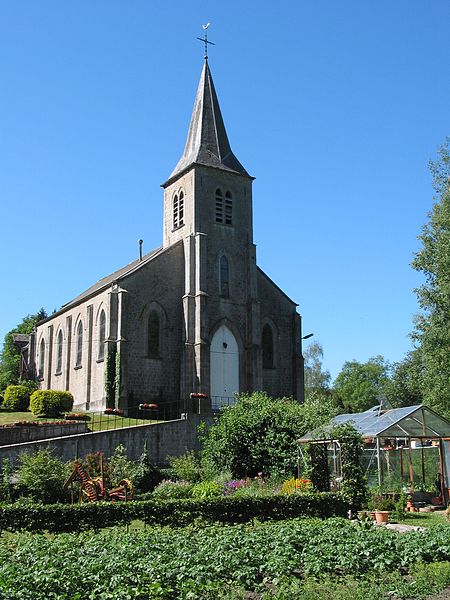David Russell Mosley

Lompret, (Belgium), the St Nicolas’ church (1879)
Ordinary Time
All Souls’ Day 2017
The Edge of Elfland
Manchester, New Hampshire
Dearest Readers,
This morning as I briefly made my way through my Facebook feed, I came across an article entitled, “Why You Hate Contemporary Architecture: And if you don’t, why you should…” by Brianna Rennix & Nathan J. Robinson. It was a fascinating, and rather long article that articulated my own misgivings about modern architecture. I was glad to see, in this article, that I was not alone. But what is more, I was happy to see some justifications for my own feelings. This a fantastic article that actually looks at the history of architecture and the way it has been taught to show how and why we have made the shifts we have.
Chief among them, according Rennix and Robinson, is a shift away from beauty. According to Rennix and Robinson, the postwar West had to deal more fully with the brutalities of life and architecture began to reflect this. Life is ugly and our architecture ought not to hide that fact. Ornamentation is bourgeois. Life is brutal and so should our homes and buildings be. Much of this comes from slightly more socialistic sources, but Rennix and Robinson point out that this was not always so. William Morris and his ilk all believed that things in life should be beautiful. And yet, architecture has shifted, capitalism, or so say our authors, and other influences have given us architecture that is either simply bleak and lifeless, or intentionally ugly. Now, Rennix and Robinson have several solutions for this, but before I engage with this I want to turn to an article from several years ago, written by an unlikely source.
Back in December of 2014, His Royal Highness Prince Charles wrote an article outlining, at the end, 10 rules that the modern architect ought to follow. Here are his ten rules:
1 Developments must respect the land. They should not be intrusive; they should be designed to fit within the landscape they occupy.
2 Architecture is a language. We have to abide by the grammatical ground rules, otherwise dissonance and confusion abound. This is why a building code can be so valuable.
3 Scale is also key. Not only should buildings relate to human proportions, they should correspond to the scale of the other buildings and elements around them. Too many of our towns have been spoiled by casually placed, oversized buildings of little distinction that carry no civic meaning.
4 Harmony − the playing together of all parts. The look of each building should be in tune with its neighbours, which does not mean creating uniformity. Richness comes from diversity, as Nature demonstrates, but there must be coherence, which is often achieved by attention to details like the style of door cases, balconies, cornices and railings.
5 The creation of well-designed enclosures. Rather than clusters of separate houses set at jagged angles, spaces that are bounded and enclosed by buildings are not only more visually satisfying, they encourage walking and feel safer.
6 Materials also matter. In the UK, as elsewhere, we have become dependent upon bland, standardized building materials. There is much too much concrete, plastic cladding, aluminium, glass and steel employed, which lends a place no distinctive character. For buildings to look as if they belong, we need to draw on local building materials and regional traditional styles.
7 Signs, lights and utilities. They can be easily overused. We should also bury as many wires as possible and limit signage. A lesson learned from Poundbury is that it is possible to rid the street of nearly all road signs by using ‘events’ like a bend, square or tree every 60-80 metres, which cause drivers to slow down naturally.
8 The pedestrian must be at the centre of the design process. Streets must be reclaimed from the car.
9 Density. Space is at a premium, but we do not have to resort to high-rise tower blocks which alienate and isolate. I believe there are far more communal benefits from terraces and the mansion block. You only have to consider the charm and beauty of a place like Kensington and Chelsea in London to see what I mean. It is often forgotten that this borough is the most densely populated one in London.
10 Flexibility. Rigid, conventional planning and rules of road engineering render all the above instantly null and void, but I have found it is possible to build flexibility into schemes and I am pleased to say that many of the innovations we have tried out in the past 20 years are now reflected in national engineering guidance, such as The Manual For Streets.
I am so fascinated by this list, though I am led to believe that many architects disdained it. Based on the more recent article by Rennix and Robinson, it is no wonder. And yet these principles seem right and to derive from common sense. Buildings should match their surroundings, they should be made for people to live in, work in, use, and observe from the outside. The should be fitting and be beautiful.
These ten points dovetail nicely with the solutions provided by Rennix and Robinson. They suggest overcoming fear (of beauty, ornament, tradition, symmetry, and looking foolish,); to be both complex and simple; to integrate nature; to put feelings over form; to have coherence; and to follow democratic values (as well as to abolish skyscrapers).
The last of these is the most interesting to me, the democratic values, not the “abolition of skyscrapers.” After all, as Rennix and Robinson note, many things are popular that are considered by many bad (the Transformers films, Thomas Kinkade, etc.). But the difference they note is that just because bad things might be popular (Fifty Shades, anyone) doesn’t mean we’re all inflicted with it. No one makes us read bad novels at night, or listen to bad music. But architects, by not following the public voice and desire, do inflict on us bad architecture.
In the end, I am drawn to discussions such as these for they have to do with beauty. And while Rennix and Robinson briefly bracket out the glory of God as the reason for making something (a cathedral for instance) beautiful. As a Catholic, I can recognize that the very reason beauty is subjective is because beauty is knit into the very fabric of reality by the One who is the source of beauty.
Sincerely,
David












